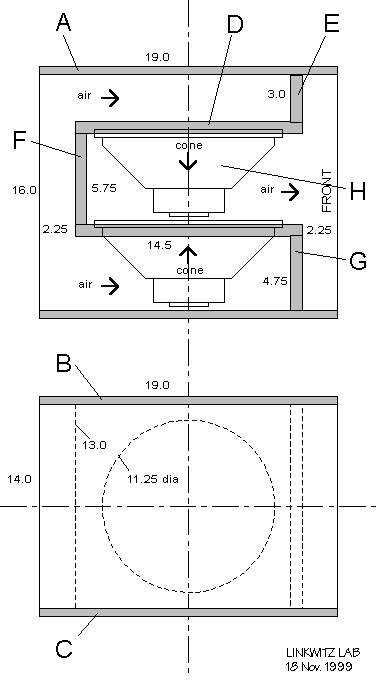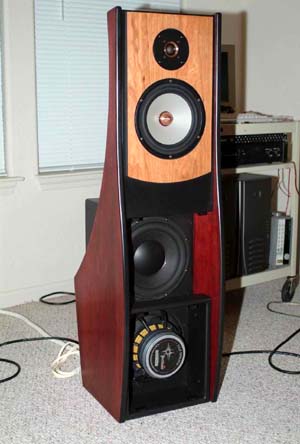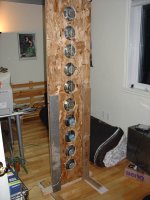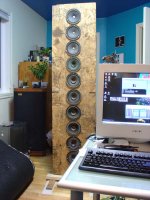Firstly, i would like to thanks every single user in here for all the info/experience sharing! 
today i have done a test line array loudpspeaker !!
Construction took a little less than 3 hours including wiring ..
Used an old presswood 18" by 70" high 3/4 thick
Drivers were scavanged from Civics 1990 to 1995 , front door speakers ..
they seem to be all the same, but the back says else..
some are made by alpine, other in the usa ..
ranging from 15W to 40W ..but i am pretty sure that they are all the same construction, and the magnets are all equivalent size and strength ..
the alpine one states 150Hz to 16khz
Wired them in 3 group of series that are then parallelled.
Should be giving something like 4.5ohm
Amplifier driving this louspeaker is my small but reliable Bryston 2B pro .. should get near 100W at 4.5ohm
Now for the real test ...
pluged this pannel to my computer replacing the left channle
Fisher limited edition loudspeaker!
The point is that i can A-B it agasin't this mid fi commercial unit!
Listening impressions :
well it sure lacks in bass!!!
nothing under 150hz ...but sub region wasn't the point of this experiment at all!
The pannel is 18" wide, wich should be good down to ~160hz before cancellation comes into play, is this correct?
this is approximatly the Freq at wich they don't play anything anymore
I was surprised at first by the loudness of this loudspeaker!
drived at the same amplifier gain, it is at least 25% louder than the Fisher unit , sensivity because of the disposition + lower impedance should be the reason why ??
Fired a few simple cds,
well this pos seems to be way more detailed than the fishers,
and i can say WAY more ..
i hear things i was only able to hear with the mirage OM-9 before they gone to the living room
i did a few A-B tests with instrumental passages, and
the line array gives resolution that the fisher cannot simply attain
i would really like to put it against the mirages...i'll see on that later
the pannel is pretty big though, kinda obstrusive, but it looks cool!
wahahhaha
i'll join pics ..please have a look at them
today i have done a test line array loudpspeaker !!
Construction took a little less than 3 hours including wiring ..
Used an old presswood 18" by 70" high 3/4 thick
Drivers were scavanged from Civics 1990 to 1995 , front door speakers ..
they seem to be all the same, but the back says else..
some are made by alpine, other in the usa ..
ranging from 15W to 40W ..but i am pretty sure that they are all the same construction, and the magnets are all equivalent size and strength ..
the alpine one states 150Hz to 16khz
Wired them in 3 group of series that are then parallelled.
Should be giving something like 4.5ohm
Amplifier driving this louspeaker is my small but reliable Bryston 2B pro .. should get near 100W at 4.5ohm
Now for the real test ...
pluged this pannel to my computer replacing the left channle
Fisher limited edition loudspeaker!
The point is that i can A-B it agasin't this mid fi commercial unit!
Listening impressions :
well it sure lacks in bass!!!
nothing under 150hz ...but sub region wasn't the point of this experiment at all!
The pannel is 18" wide, wich should be good down to ~160hz before cancellation comes into play, is this correct?
this is approximatly the Freq at wich they don't play anything anymore
I was surprised at first by the loudness of this loudspeaker!
drived at the same amplifier gain, it is at least 25% louder than the Fisher unit , sensivity because of the disposition + lower impedance should be the reason why ??
Fired a few simple cds,
well this pos seems to be way more detailed than the fishers,
and i can say WAY more ..
i hear things i was only able to hear with the mirage OM-9 before they gone to the living room
i did a few A-B tests with instrumental passages, and
the line array gives resolution that the fisher cannot simply attain
i would really like to put it against the mirages...i'll see on that later
the pannel is pretty big though, kinda obstrusive, but it looks cool!
wahahhaha
i'll join pics ..please have a look at them
Attachments
JinMTVT said:
.....do you guys think it would sound better enclosed with the back wave controlled ??
here is the front pic
No. Open baffle sounds so nice and clear partly because there is no cabinet coloration. Put sides and a back on this and once again you will have that problem.
JinMTVT said:why is it then, that there isn't more commercial units using dipole config?
what are the cons of dipole in my array ?
Partly I guess is because they have to be fairly large to work properly and most 'consumers' have been programmed to lust after teeny weeny black plastic crap boxes with fake woodgrain finish applied that the manufacturers have spent lots of money advertising to 'educate' the consumer that this is what is 'hot'.
Manufacturers do not have to strive for better sound, only to provide what gullible consumers will buy. Remember Bose?!
There is also the WAF which often requires that the loudspeaker have a large enough top surface so as to be able to pile crap, 'er I mean 'decorative items' on top of. A thin top edge of a baffle is of little use here.
Now this is just my idea and I COULD BE WRONG.

There are no cons in your array unless the doors you obtained the drivers from were on stolen cars.
Dipoles have their place and are interesting to experiment with. Dipole arrays are a fun extension of this concept. They don't work pushed up in a corner or tight against a wall, so for this reason some folks will not be able to use them in their listening room for furniture layout reasons.
nice reply...thanks 
though i would like more technical info
( didn't get enough from Linkwitz .. )
And NO the speakers aren't from stolen car doors
i just happen to own an auto recycle part buisness
so i guess i have access to lots of 4ohm free speakers
One thing i still do not understand at all .
if the baffled dipole subs firing in reverse ???
what is the purpose of this?
doesn't the wave of both nulls out?
taling about this kind of sub :


though i would like more technical info
( didn't get enough from Linkwitz .. )
And NO the speakers aren't from stolen car doors
i just happen to own an auto recycle part buisness
so i guess i have access to lots of 4ohm free speakers
One thing i still do not understand at all .
if the baffled dipole subs firing in reverse ???
what is the purpose of this?
doesn't the wave of both nulls out?
taling about this kind of sub :


Nice work  How come you didn't butt them up against eachother and left what looks like about 1" between them? I had this exact same idea, my buddy works at Circuit City and he asked his car install dept if he could score some replacement speakers. They said that by law they had to return them to the car owners. How did you get yours?
How come you didn't butt them up against eachother and left what looks like about 1" between them? I had this exact same idea, my buddy works at Circuit City and he asked his car install dept if he could score some replacement speakers. They said that by law they had to return them to the car owners. How did you get yours?
--
Danny
--
Danny
there is in fact approximatly 1/4" in between each driver
i could'nt get them closer because of the way their frame is cast
for the drviers ...well read my last post
also the details in this small experiment weren't quite important,
only wanted to try it out and see the potential of this design!
quite good for the poor quality of the drivers i might say!!!
i could'nt get them closer because of the way their frame is cast
for the drviers ...well read my last post
also the details in this small experiment weren't quite important,
only wanted to try it out and see the potential of this design!
quite good for the poor quality of the drivers i might say!!!
I bet if you got close enough to the Fishers you'd find they wouldn't sound that much different
http://www.livesoundint.com/archives/2002/septoct/man/man.php
(go down to 2nd question)
http://www.livesoundint.com/archives/2003/sept/jbl/jbl.php
www.jblpro.com/vertec1/doug button 258 final rev c.pdf
http://www.livesoundint.com/archives/2002/septoct/man/man.php
(go down to 2nd question)
http://www.livesoundint.com/archives/2003/sept/jbl/jbl.php
www.jblpro.com/vertec1/doug button 258 final rev c.pdf
EVEN THOUGh the distortion is probably lower in your OB LA, you do have to make sure that the level of the two speakers is exactly the same. Very small increases in dB can make one speaker sound clearer over another. Crank the fisher and see if that makes any difference. PLus the open baffle is not going to hurt here.
As for the dipole woofer you mentioned, one of the drivers is out of phase with the other, so the cones are actually moving in opposite directions when DC is applied. The end result is that any sort of nonlinearity in the motor and suspension structure of the woofers is cancelled out, lowering distortion further. So, that's how that works. Go to PartsExpress.com and buy the paper-cone Pioneer 15" woofers with foam surrounds. Those have a Qts of 0.7, which makes them perfect for an application like this because the suspension already provides the sound of a Qtc 0.7 (theoretically ideal) sealed box, when used in free air. Then build a version of the Phoenix dipole woofer, crossover at about 200 Hz, and you'll have your dipole bass.
ok isee now!
so the drivers are connected 180 degree so that on the same side they both pull but one from the front and one from the rear.
i guess that they aren't using this for nothing, so the improvements should be there!
any grpahs for response of this kind of setup VS sealed or TL type enclosure?
any number on distortion levels VS enclosed type subs?
do you think that this kind of setup would work up to 500hz
with a good sub?
so the drivers are connected 180 degree so that on the same side they both pull but one from the front and one from the rear.
i guess that they aren't using this for nothing, so the improvements should be there!
any grpahs for response of this kind of setup VS sealed or TL type enclosure?
any number on distortion levels VS enclosed type subs?
do you think that this kind of setup would work up to 500hz
with a good sub?
JinMTVT said:ok isee now!
so the drivers are connected 180 degree so that on the same side they both pull but one from the front and one from the rear.
i guess that they aren't using this for nothing, so the improvements should be there!
any grpahs for response of this kind of setup VS sealed or TL type enclosure?
any number on distortion levels VS enclosed type subs?
do you think that this kind of setup would work up to 500hz
with a good sub?
No, I think 500 Hz is too high a crossover point for a woofer package like this where there are chambers involved that exceed 1/4 wavelength in size (~6") and the part of the driver cone that radiates these is not in line-of-sight with the listener, or time aligned with the other mid driver(s).
ok i did more linstening today ..lots of it 
( hey hey,isn't the point of all our efforts to listen to music?
well, at equal volume, both loudspeaker don't sound quite the same.
one problem i have in discerning the particular sound of each system is that the Fisher does resolve stuff under 150hz pretty good, where the LA doesn't at all
was expected with the poor drivers + dipole used in the LA
Since i am far from an experienced listener, please don't take too seriously the following points ..
At first, the LA seemed alot more articulate than the fisher, in resolving complicated sounds ( trumpets, multiple voices timbres same time .. )
this effect has now lessen with each listening and the equalization in volume between both system
When doing AB with mono output ( using balance fader in software ) i can point a few differences but cannot clearly determine wich one as the best redering of the audio.
The LA is realy missing in 10KHZ+ definition , of course the Fisher uses a tweeter and a 2" mid-high drivers thus getting more resolution in that 10KHZ+ range ..
the mids seems to be better on the LA
strong and fast
Sensitivity on the LA is really high, as high as half gain+ 3/4 volume control on software = ear piercing highs!!
kinda dangerous though ..ahha
Going back to dipole operation ..
I have read ( again ) today lots of pages including Linkwitz's on dipole systems and line array ( line sources ) loudpseakers
From what i understood, open end dipole operation
( wich a sufficient front baffle size) seems to be the best way to get low distortion and high quality sound reproduction?
even when used with subs it seems to perform excellently quoting a few of the users in here.
Why aren't more commercial units using this design?
I mean, why when we think of speakers, we see an enclosure?
I guess than the box is a way to control the rear wave, but why then suddently ( since a few years i guess?? ) dipole config seems to be "a la mode" in the audio diy world?
Does it really provides a better way of reproduction musical content than conventional enclosed driver? ( assuming that equal quality drivers are used )
then, would a system as i just did for testing, but using high quality materials provide an even better solution?
quoted from Linkwitz site :
This means ( if he is right, and i assume he is for now )
)
that more drivers = less distotion in the sound producing operation? is it because of the distributed area thus requiring less
movmement from each individual drivers to produce the same total loudness??
Then if he really meant to say that the only disagvantage to line sources are:
- image distortion
-are unnecessarily large
i guess i could live up with those 2 things pretty good

this is only my humble comments ...
( hey hey,isn't the point of all our efforts to listen to music?
well, at equal volume, both loudspeaker don't sound quite the same.
one problem i have in discerning the particular sound of each system is that the Fisher does resolve stuff under 150hz pretty good, where the LA doesn't at all
was expected with the poor drivers + dipole used in the LA
Since i am far from an experienced listener, please don't take too seriously the following points ..
At first, the LA seemed alot more articulate than the fisher, in resolving complicated sounds ( trumpets, multiple voices timbres same time .. )
this effect has now lessen with each listening and the equalization in volume between both system
When doing AB with mono output ( using balance fader in software ) i can point a few differences but cannot clearly determine wich one as the best redering of the audio.
The LA is realy missing in 10KHZ+ definition , of course the Fisher uses a tweeter and a 2" mid-high drivers thus getting more resolution in that 10KHZ+ range ..
the mids seems to be better on the LA
strong and fast
Sensitivity on the LA is really high, as high as half gain+ 3/4 volume control on software = ear piercing highs!!
kinda dangerous though ..ahha
Going back to dipole operation ..
I have read ( again ) today lots of pages including Linkwitz's on dipole systems and line array ( line sources ) loudpseakers
From what i understood, open end dipole operation
( wich a sufficient front baffle size) seems to be the best way to get low distortion and high quality sound reproduction?
even when used with subs it seems to perform excellently quoting a few of the users in here.
Why aren't more commercial units using this design?
I mean, why when we think of speakers, we see an enclosure?
I guess than the box is a way to control the rear wave, but why then suddently ( since a few years i guess?? ) dipole config seems to be "a la mode" in the audio diy world?
Does it really provides a better way of reproduction musical content than conventional enclosed driver? ( assuming that equal quality drivers are used )
then, would a system as i just did for testing, but using high quality materials provide an even better solution?
quoted from Linkwitz site :
...Vertical height of the sound stage adds to its realism. I find small 2-way speakers very unsatisfactory in this respect, even when they are correctly positioned at ear level height. ...
An added advantage of tall sources is their relatively large radiating surface area, which means small excursions and, therefore, progressively lower non-linear distortion for a given maximum sound level. The low distortion aspect is even more important, than sound stage height, wide angle horizontal dispersion and uniform power response. Low distortion means increased dynamics and clarity, and the ability to play back at near live levels without listener strain. It brings the naturally occurring distortion mechanisms of the ear into play, which are necessary elements for creating an illusion of reality.
Sensitivity can be high. A line with 25 identical drivers connected in series-parallel to obtain the same combined impedance as that of a single driver, will have 14 dB higher SPL for the same voltage applied.
Stored energy is not necessarily low because of the many cabinet and driver chassis cavities.
I would encourage more investigation of line sources for use in very large venues, as for public address or entertainment speakers. For typical domestic environments they are unnecessarily large. Today, the same low distortion sound pressure levels can be obtained from far fewer drivers and without the image distortion.
This means ( if he is right, and i assume he is for now
that more drivers = less distotion in the sound producing operation? is it because of the distributed area thus requiring less
movmement from each individual drivers to produce the same total loudness??
Then if he really meant to say that the only disagvantage to line sources are:
- image distortion
-are unnecessarily large
i guess i could live up with those 2 things pretty good
this is only my humble comments ...
Flat / "U" Open Baffle Ft
Hi,
Some side 'wings' will lower FR > an octave.
Flat Baffle Ft{F of transition from dipole to Two 2Pi Radiators}
is ~ 6780 / (Width / 2), Lambda/2 from center to edge.
"U" Baffle is ~ 6780 / (Width + Depth) {SL}
Sides ~= (W / 3) has about a +3db peak @ Ft. and
then drop -6db/oct lower.
LS
Hi,
Some side 'wings' will lower FR > an octave.
Flat Baffle Ft{F of transition from dipole to Two 2Pi Radiators}
is ~ 6780 / (Width / 2), Lambda/2 from center to edge.
"U" Baffle is ~ 6780 / (Width + Depth) {SL}
Sides ~= (W / 3) has about a +3db peak @ Ft. and
then drop -6db/oct lower.
LS
My friend, Dmiti has some good info on his site about OB line arrays. They can image very well, you just need a concave baffle. Check out http://www.geocities.com/dmitrynizh/labaffles.htm
JinMTVT, if you have an unlimited supply of drivers, then you can do dipole bass too with those cheap little drivers. You need to use alot of them and there's some special considerations that must be taken into account when loading below the resonant frequency (Fs) of a driver. The the case of the ones you have, the Fs is probably 80-100hz.
My next array project will be an adjustable baffle, which will go from straight to various concave degrees to suit different listening situations and of course "wings" on hinges.
Regarding wings, see Dmitri's example for adjustable wings. For yours, add a 10" piece of wood to the back or side and 5" on the other side and the sound will be much fuller, but still a little thin.
Regarding sensitivity: You get 3db more output every time you double the number of drivers. You also pick up some sensitivity going to OB because the back wave energy is put into play instead of disipating in a box.
Dipoles aren't popular for mass marketed speakers because you can't get dipole bass nearly as cheaply as you can make boxed bass.
JinMTVT, if you have an unlimited supply of drivers, then you can do dipole bass too with those cheap little drivers. You need to use alot of them and there's some special considerations that must be taken into account when loading below the resonant frequency (Fs) of a driver. The the case of the ones you have, the Fs is probably 80-100hz.
My next array project will be an adjustable baffle, which will go from straight to various concave degrees to suit different listening situations and of course "wings" on hinges.
Regarding wings, see Dmitri's example for adjustable wings. For yours, add a 10" piece of wood to the back or side and 5" on the other side and the sound will be much fuller, but still a little thin.
Regarding sensitivity: You get 3db more output every time you double the number of drivers. You also pick up some sensitivity going to OB because the back wave energy is put into play instead of disipating in a box.
Dipoles aren't popular for mass marketed speakers because you can't get dipole bass nearly as cheaply as you can make boxed bass.
- Status
- This old topic is closed. If you want to reopen this topic, contact a moderator using the "Report Post" button.
- Home
- Loudspeakers
- Multi-Way
- Playing with cheap line array is fun!

